
Circe, minor planet designation 34 Circe, is a large, very dark main-belt asteroid. It was discovered by French astronomer J. Chacornac on April 6, 1855, and named after Circe, the bewitching queen of Aeaea island in Greek mythology.

Leto is a large main belt asteroid that is orbiting the Sun. The asteroid was discovered by German astronomer Robert Luther on April 29, 1861, and is named after Leto, the mother of Apollo and Artemis in Greek mythology. It is orbiting at a distance of 2.78112 AU with a period of 4.64 years and an orbital eccentricity of 0.187. The orbital plane is inclined at an angle of 7.97° to the ecliptic.

Nemesis is a large 180 km main-belt asteroid, of carbonaceous composition. It rotates rather slowly, taking about 78 hours to complete one rotation. Nemesis is the largest member of the Nemesian asteroid family bearing its name. It was discovered by J. C. Watson on 25 November 1872, and named after Nemesis, the goddess of retribution in Greek mythology.

168 Sibylla is a large main-belt asteroid, discovered by Canadian-American astronomer J. C. Watson on September 28, 1876. It was most likely named for the Sibyls, referring to the Ancient Greek female oracles. Based upon its spectrum this object is classified as a C-type asteroid, which indicates it is very dark and composed of primitive carbonaceous materials. 168 Sibylla is a Cybele asteroid, orbiting beyond most of the main-belt asteroids.

196 Philomela is a large and bright main-belt asteroid. It is an S-type asteroid.

Isabella is a large and dark asteroid from the central asteroid belt, approximately 80 kilometers in diameter. It was discovered in Pola by Johann Palisa on 12 November 1879. The origin of the name is unknown. The asteroid is probably composed of material similar to carbonaceous chondrites. It is classified as a member of the Nemesis family of asteroids.
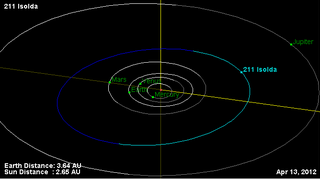
Isolda is a very large, dark main-belt asteroid. It is classified as a C-type asteroid and is probably composed of primitive carbonaceous material. The spectra of the asteroid displays evidence of aqueous alteration.
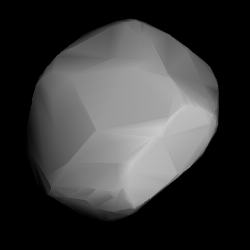
Hypatia is a very large main-belt asteroid that was discovered by Russian astronomer Viktor Knorre on July 1, 1884, in Berlin. It was the third of his four asteroid discoveries. The name was given in honour of philosopher Hypatia of Alexandria. Based upon the spectrum, it is classified as a C-type asteroid and is probably composed of primitive carbonaceous material. Like many asteroids of this type, its surface is very dark in colour.

Olga is a large Main belt asteroid. It is classified as a C-type asteroid and is probably composed of carbonaceous material.
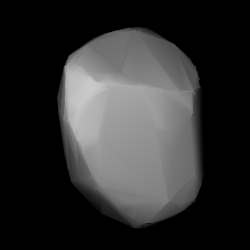
Gudrun is a main-belt asteroid.
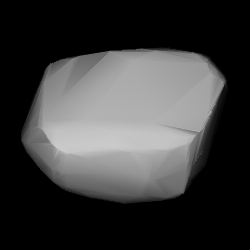
Chicago is a very large main-belt asteroid. It is classified as a C-type asteroid and is probably composed of carbonaceous material.

Tercidina is a large main-belt asteroid. It is classified as a C-type asteroid and is probably composed of carbonaceous material.

Dembowska is a large asteroid of the main belt, discovered on 9 December 1892, by the French astronomer Auguste Charlois while working at the observatory in Nice, France. It is named in honor of the Baron Hercules Dembowski, an Italian astronomer who made significant contributions to research on double and multiple stars.

Siegena is a very large main-belt asteroid. It is classified as a C-type asteroid and is probably composed of primitive carbonaceous material.
Patientia is approximately the 15th-largest asteroid in the asteroid belt with a diameter of 225 km. It was discovered by French astronomer Auguste Charlois on 4 December 1899, and assigned a provisional designation 1899 EY.

Papagena is an asteroid that was discovered by German astronomer Max Wolf on 7 June 1901. Its provisional name was 1901 GN.

Princetonia is a large asteroid, a type of minor planet, orbiting in the asteroid belt. It was discovered by Raymond Smith Dugan at Heidelberg, Germany in 1903 and named "Princetonia" for Princeton University in New Jersey in the United States.
Olympia is a minor planet orbiting the Sun.
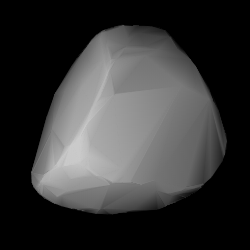
626 Notburga is a large, dark asteroid orbiting the Sun in the asteroid belt.
804 Hispania is a minor planet orbiting the Sun. It was discovered from Barcelona (Spain) on 20 March 1915 by Josep Comas Solá (1868–1937), the first asteroid to be discovered by a Spaniard.

















